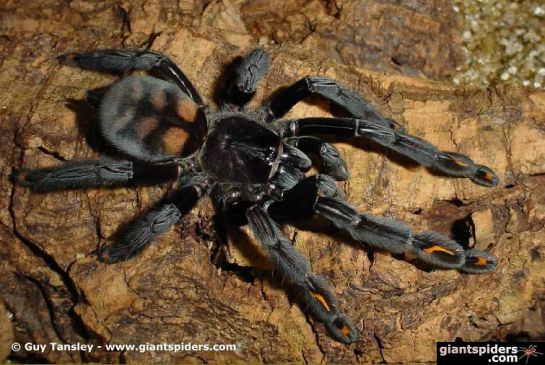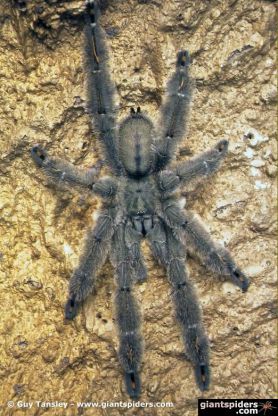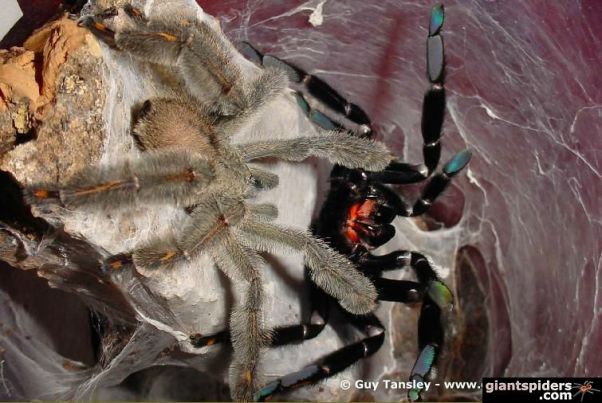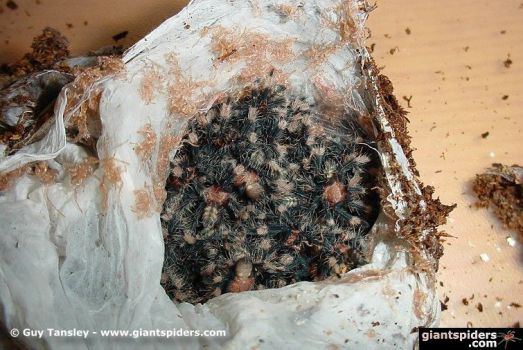
Captive care and breeding of Psalmopoeus irminia
Guy Tansley
Psalmopoeus irminia Saager, 1994 has been a long time favourite in my collection but over the six or so years of keeping this species, successful breeding has eluded me until recently.
Description: Relatively new to the hobby (only described in 1994), P. irminia is a stunning spider. Arboreal in nature and originating from Venezuela, this species grows to a large size (up to 15cm legspan in some specimens) and like other members of the genus, grows fast under the right conditions. It is similar in shape and size to its close relative P. cambridgei but much more beautifully coloured. The overall colour is black but this contrasts with the red/orange colouring in between the chevrons on the abdomen and the characteristic ‘lightening-strike’ markings on the metatarsus and tarsus.
Mature males differ from females quite a lot. The whole spider is covered with white-tipped, dark grey bristles giving the spider an overall hairy appearance, especially on the long legs. Although muted, the abdomen retains its chevrons but lacks the red/orange colouration of the female. The lightning-strike markings to the metatarsi and tarsi remain however, and some specimens may have a green tinge, especially when freshly moulted.
Housing: A typical arboreal set-up is ideal for housing P. irminia (suitably sized tall container – custom made tank or large sweet jar for example, an inch or so of slightly moist substrate and a slab of cork bark/bamboo tube to act as a retreat. At all stages in its development, this species will burrow somewhat and incorporate substrate into its webbing making for an interesting display animal. Reclusive by day but active at night, it can be seen sitting out in the open on the cork bark searching for its prey (crickets, cockroaches etc will suffice in captivity). Voracious feeders, P. irminia will grow rapidly if well fed and females can mature in 18 months or so with the males maturing slightly earlier. Average temperatures and humidity are required (75oF / 70%) and with most arboreal species, good ventilation is essential.
Breeding: Unmated P. irminia are known to produce infertile ‘phantom’ eggsacs in captivity and mine have been no exception. My oldest female (notes going back to 1998) shows that she did so in 1999 and then again in 2001. The first infertile eggsac was approximately 35mm in diameter and contained around 100 fully formed eggs. At the time the female only measured around 10cm legspan, confirming that many species are sexually mature a lot earlier than physically. The first eggsac was removed for photographs but the second remained with the female before being eaten. 3 months after this second eggsac, I acquired a mature male and attempted my first paring.
Mating is straight forward with a receptive female and a fresh, sperm-web building male. As is usual, the male is introduced to the females’ enclosure (she is usually hidden in her retreat at this point) and he should start courtship on contact with her silk. A series of vibrations and body-shaking follow as the male moves towards the female and receptive females will respond by eagerly drumming back to the male and eventually emerging from her retreat. Using his tibial apophysis, the male secures the females fangs and pushing her backwards, he inserts his palps into her epigynum and he may alternate here, using each palp several times. He makes a hasty retreat once finished and females may chase the male occasionally but I have yet to lose a fresh male to a female in this way. Females will pair more than once with the same male without any problems although it is not considered necessary.
Approximately 4 weeks later, an eggsac was produced but later discarded as it had desiccated unfortunately. A second eggsac was produced some 12 weeks later but was eventually eaten by the female. After moulting, the female was paired again with a new male but the eggsac was once again eaten. Using the same male, another pairing occurred and approximately 12 weeks later another eggsac was produced. Fearing more problems, it was decided to remove this eggsac and to try and artificially incubate it myself. The eggsac was incubated with some success but as the spiderlings were turning dark to go through their first proper moult into spiderlings, they died off one by one. There was some mould present but looking back, I believe that it was due to lack of water on the paper towel used for the hammock (nymphs are able to drink at this stage and although humid, access to water was missing). Eventually the female moulted and at the time of writing, is mated and looking fat.
Around this time, a smaller, younger female was paired with the same male but this time I was to have success. An eggsac was produced some 12 weeks after mating and the eggsac left with the female. (I only remove eggsacs from female spiders if there have been problems in the past). During incubation, the female was sealed inside her retreat and no food was offered. The female guarded the eggsac jealously for 8 weeks until the nymphs emerged to fill the inside of the retreat. 4 weeks later all of the nymphs had moulted into spiderlings and were eventually separated (108 large and healthy spiderlings in total). The female was re-housed and fed generously in the following days.
In summary, a fast growth rate, spinning an interesting arboreal retreat and relatively active behaviour all make P. irminia a fantastic species to rear and breed. Caution is advised when purchasing specimens to avoid hybrids as P. cambridgei and P. irminia are known to cross breed. Hybridised specimens tend to be more greenish in colouration (especially on the carapace) and lack the distinctive black colour of true specimens. There are rumours that P. irminia may just be a colour variation of P. cambridgei (or vice versa) but even if this is the case, do we really want to mix these two forms?
This article first appeared in the Journal of the British Tarantula Society, 26 (4): 137-140 (2011).



